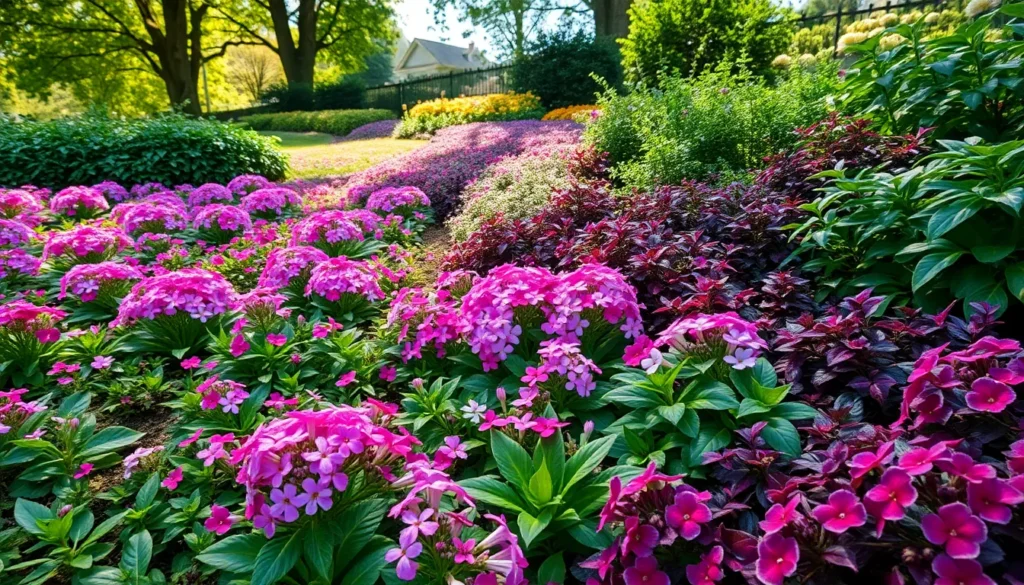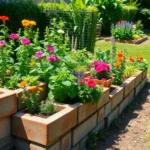We’ve all faced those challenging spots in our gardens where grass won’t grow or weeds keep taking over. Whether it’s a shady corner under trees or a steep slope that’s hard to maintain, finding the right ground cover can transform these problem areas into stunning industry features.
Ground covers aren’t just practical answers – they’re design opportunities waiting to happen. From colorful flowering varieties that create seasonal interest to hardy evergreen options that provide year-round beauty, the right choice can reduce maintenance while adding texture and visual appeal to your outdoor space.
We’re here to share the most effective ground cover ideas that’ll solve your landscaping challenges and elevate your garden’s aesthetic. These low-maintenance alternatives will save you time on weeding and watering while creating the lush, polished look you’ve been dreaming of.
Choose Low-Maintenance Perennial Ground Covers for Year-Round Beauty
Perennial ground covers solve multiple landscaping challenges while providing lasting beauty that returns each season. We’ve selected three exceptional varieties that thrive with minimal care and deliver consistent performance throughout the growing year.
Creeping Phlox for Colorful Spring Blooms
Creeping phlox transforms bare slopes and rocky areas into stunning carpets of color each spring. This hardy perennial spreads 12 to 18 inches wide and grows only 4 to 6 inches tall, making it perfect for filling gaps between stepping stones or cascading over retaining walls.
We recommend planting creeping phlox in full sun to partial shade for optimal flowering performance. The plant produces masses of small, fragrant flowers in pink, purple, white, or blue that bloom for 3 to 4 weeks in late spring. After blooming, the needle-like evergreen foliage provides year-round texture and remains attractive through winter months.
Creeping phlox tolerates poor soil conditions and drought once established, requiring water only during extended dry periods. The plant self-seeds readily and spreads through underground runners, creating dense coverage within 2 to 3 years without aggressive maintenance.
Pachysandra for Dense Shade Coverage
Pachysandra excels in deep shade areas where most other ground covers struggle to survive. This evergreen perennial forms thick mats 6 to 12 inches tall that effectively suppress weeds and create uniform coverage under large trees or along north-facing foundations.
We find pachysandra particularly valuable for its glossy, dark green leaves that maintain their color throughout winter months. The plant produces small white flower spikes in early spring, though we grow it primarily for its reliable foliage coverage. Each plant spreads 12 to 18 inches through underground rhizomes, filling large areas efficiently.
Pachysandra thrives in moist, well-draining soil with consistent moisture but adapts to various soil types once established. The plant requires minimal fertilization and rarely suffers from pest or disease problems, making it ideal for low-maintenance shade gardens.
Vinca Minor for Versatile Growing Conditions
Vinca minor adapts to more growing conditions than most ground covers, thriving in full sun to deep shade locations. This evergreen perennial creates dense mats of glossy, dark green leaves punctuated by purple, blue, or white flowers that bloom sporadically from spring through fall.
We appreciate vinca minor’s ability to stabilize slopes and prevent erosion while requiring virtually no maintenance once established. The plant grows 4 to 6 inches tall and spreads indefinitely through trailing stems that root at nodes, creating seamless coverage over large areas.
Vinca minor tolerates drought, poor soil, and foot traffic better than many alternatives, making it suitable for challenging locations. The plant remains evergreen in most climates and recovers quickly from winter damage, ensuring consistent appearance year after year.
Select Fast-Spreading Ground Covers for Quick Coverage
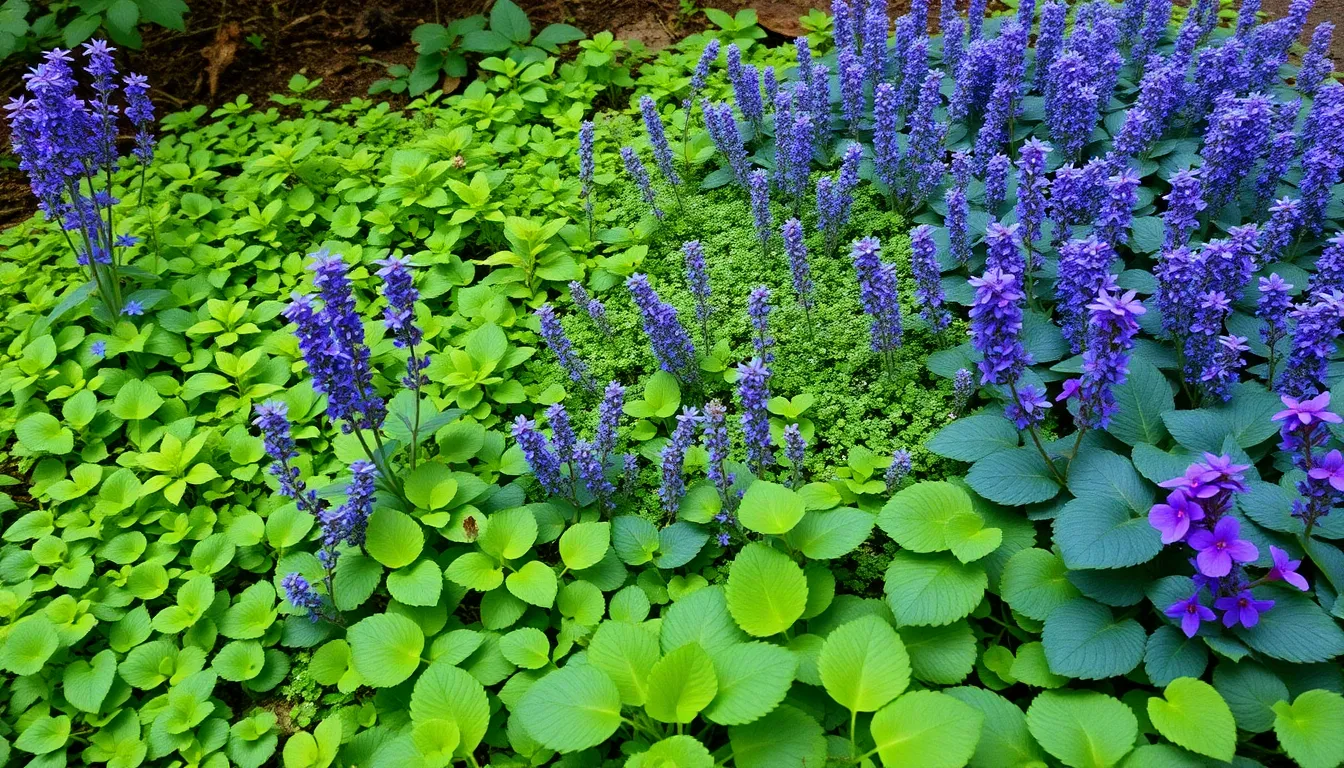
When we need to establish coverage quickly in challenging areas, fast-spreading ground covers become our most valuable allies. These vigorous plants can transform bare patches into lush carpets within a single growing season.
Ajuga for Rapid Expansion and Purple Flowers
Ajuga delivers exceptional results when we’re looking for quick coverage with stunning spring color. This fast-spreading ground cover, also known as Bugleweed, forms dense mats that fill gaps rapidly while producing beautiful blue or purple flower spikes in spring.
We particularly appreciate Ajuga’s ability to thrive in partial shade where other ground covers struggle. Its low maintenance requirements make it perfect for areas we want to establish and forget, while its rapid growth ensures we won’t wait long to see results.
Dense mat formation becomes one of Ajuga’s strongest features, allowing it to suppress weeds naturally while creating uniform coverage. The plant’s vigorous spreading habit means we can plant fewer specimens and still achieve full coverage within months rather than years.
Creeping Thyme for Aromatic Walkable Surfaces
Creeping Thyme stands out as our top choice for areas that receive foot traffic while still providing rapid coverage. This fast-growing ground cover thrives in full sun to partial shade and prefers well-drained soil, making it ideal for walkways and stepping stone paths.
We love how this aromatic plant releases its delightful fragrance when walked upon, creating a sensory experience in our gardens. Its durable nature means we don’t have to worry about occasional foot traffic damaging our ground cover investment.
Fragrant leaves and flowers provide dual benefits, offering both culinary potential and garden beauty. The plant’s low-growing habit ensures it won’t interfere with foot traffic while still providing the dense coverage we need to suppress weeds and create visual interest.
Wild Ginger for Moist Woodland Areas
Wild Ginger excels in those challenging shaded, moist areas where we struggle to establish other ground covers. This North American native (Asarum canadense) creates dense carpets with its distinctive heart-shaped leaves, making it perfect for woodland gardens and naturalized areas.
We find Wild Ginger particularly valuable for its ability to spread quickly in environments that challenge most other plants. Its soft, hairy leaves create interesting texture while forming the thick coverage we need to suppress weeds and create a finished look.
Shaded environments become Wild Ginger’s specialty, allowing us to achieve beautiful results in areas where sun-loving ground covers fail. The plant’s rapid spreading ability means we can establish coverage quickly even in these challenging conditions, creating lush woodland floors that require minimal maintenance once established.
Consider Evergreen Ground Covers for Winter Interest
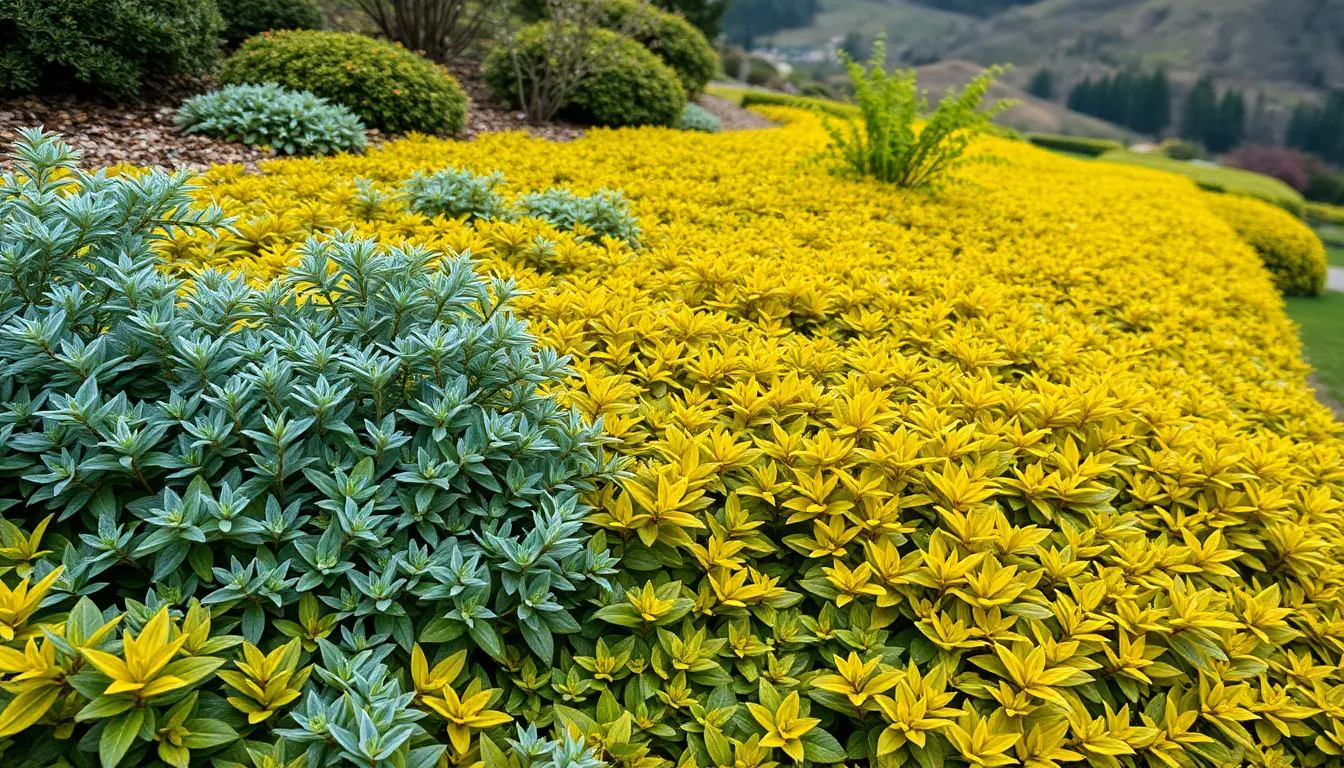
Evergreen ground covers ensure your garden maintains visual appeal throughout the coldest months. We recommend selecting varieties that provide year-round foliage color and texture while requiring minimal maintenance during winter dormancy.
Juniper Varieties for Drought Tolerance
Juniper varieties excel in water-wise landscaping while delivering stunning winter interest. Creeping Juniper (Juniperus horizontalis) spreads naturally across slopes and flat areas with its distinctive silvery-blue to golden-yellow foliage that deepens in winter months. These hardy shrubs adapt to various soil conditions and require virtually no supplemental watering once established.
We’ve found that juniper’s spreading habit makes it perfect for covering large areas quickly. The foliage ranges from rich green to striking golden tones that intensify during colder weather. Drought tolerance allows these ground covers to thrive in challenging locations where other plants struggle to survive.
Ivy for Steep Slopes and Difficult Areas
Ivy transforms problematic garden areas into lush green carpets that remain vibrant year-round. English Ivy (Hedera helix) climbs steep slopes and banks where erosion threatens garden stability. This versatile ground cover adapts to full shade through partial sun while tolerating various soil types from clay to sandy loam.
We recommend ivy for areas where traditional grass won’t establish or maintain coverage. The dense mat formation prevents soil erosion on challenging slopes while requiring minimal care once established. Glossy leaves provide consistent color throughout winter when most other plants go dormant.
Wintergreen for Edible Berries and Fragrance
Wintergreen offers unique sensory benefits alongside its attractive evergreen coverage. Wintergreen (Gaultheria procumbens) produces bright red berries that persist through winter months while releasing minty fragrance from its leaves when crushed. This native ground cover prefers moist, acidic soils and thrives in partial shade conditions common in woodland gardens.
We appreciate wintergreen’s dual-purpose nature as both ornamental and edible landscaping. The berries attract winter wildlife while the aromatic leaves can be harvested for teas and natural remedies. Low-growing habit creates dense mats that suppress weeds while maintaining year-round interest through both foliage and fruit.
Plant Native Ground Covers for Local Ecosystem Support
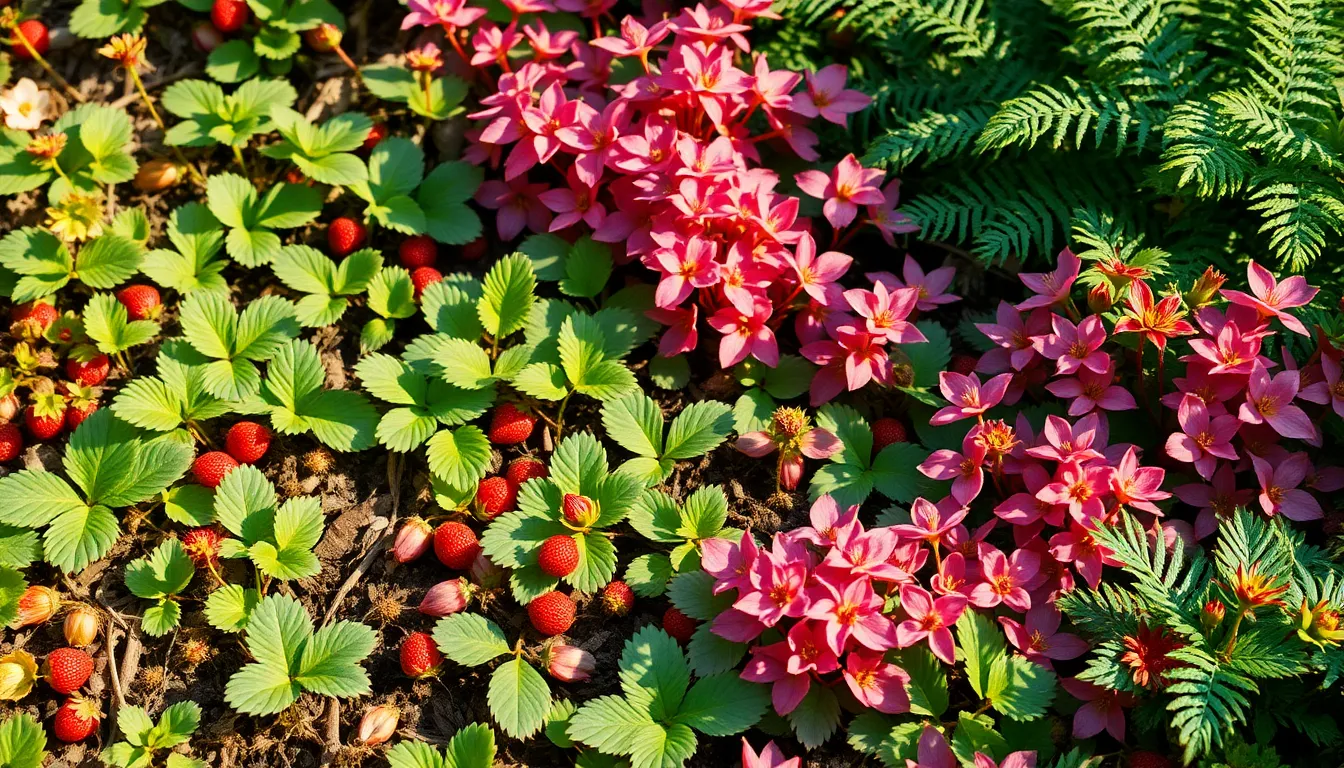
Native ground covers transform challenging garden spaces while supporting local wildlife and reducing maintenance demands. These plants adapt naturally to local conditions, requiring 30-50% less water and fertilizer than non-native alternatives while providing essential habitat for insects, birds, and mammals.
Wild Strawberry for Edible Fruit Production
Wild strawberry (Fragaria virginiana) delivers both ornamental beauty and edible rewards in our North American gardens. This low-growing native spreads naturally to create dense mats that suppress weeds while producing sweet, small fruits in early summer.
Dainty white flowers appear in late spring, attracting pollinators before developing into flavorful berries that wildlife and gardeners alike appreciate. We recommend planting wild strawberry in sunny to lightly shaded areas where it’ll establish quickly and require minimal care. The plant’s green foliage provides year-round ground coverage, making it an excellent choice for naturalizing areas or replacing traditional lawn grass in challenging spots.
Coral Bells for Attractive Foliage Colors
Heuchera species bring vibrant foliage colors to shaded garden areas where many ground covers struggle to thrive. These perennial plants showcase leaves in burgundy, purple, lime green, and silver tones that create striking visual contrast throughout the growing season.
Coral bells adapt well to partial shade and well-draining soil conditions, making them perfect for areas under trees or along north-facing slopes. Their colorful foliage provides year-round interest while delicate flower spikes attract hummingbirds during blooming periods. We find these plants particularly valuable for brightening spaces where lawn grass fails to establish, offering both beauty and low-maintenance coverage.
Ferns for Natural Woodland Appearance
Ferns like Christmas fern (Polystichum acrostichoides) create lush, woodland aesthetics in shaded, moist garden areas. These plants develop arching fronds that form soft textural carpets while effectively suppressing weed growth through dense coverage.
Their natural growth habit requires no pruning or special care, making them ideal for gardeners seeking minimal maintenance answers. We recommend ferns for stabilizing slopes or covering ground in areas with limited sunlight where other plants struggle to survive. The graceful fronds add elegance to naturalized areas while contributing to soil conservation and erosion control.
Incorporate Flowering Ground Covers for Seasonal Color
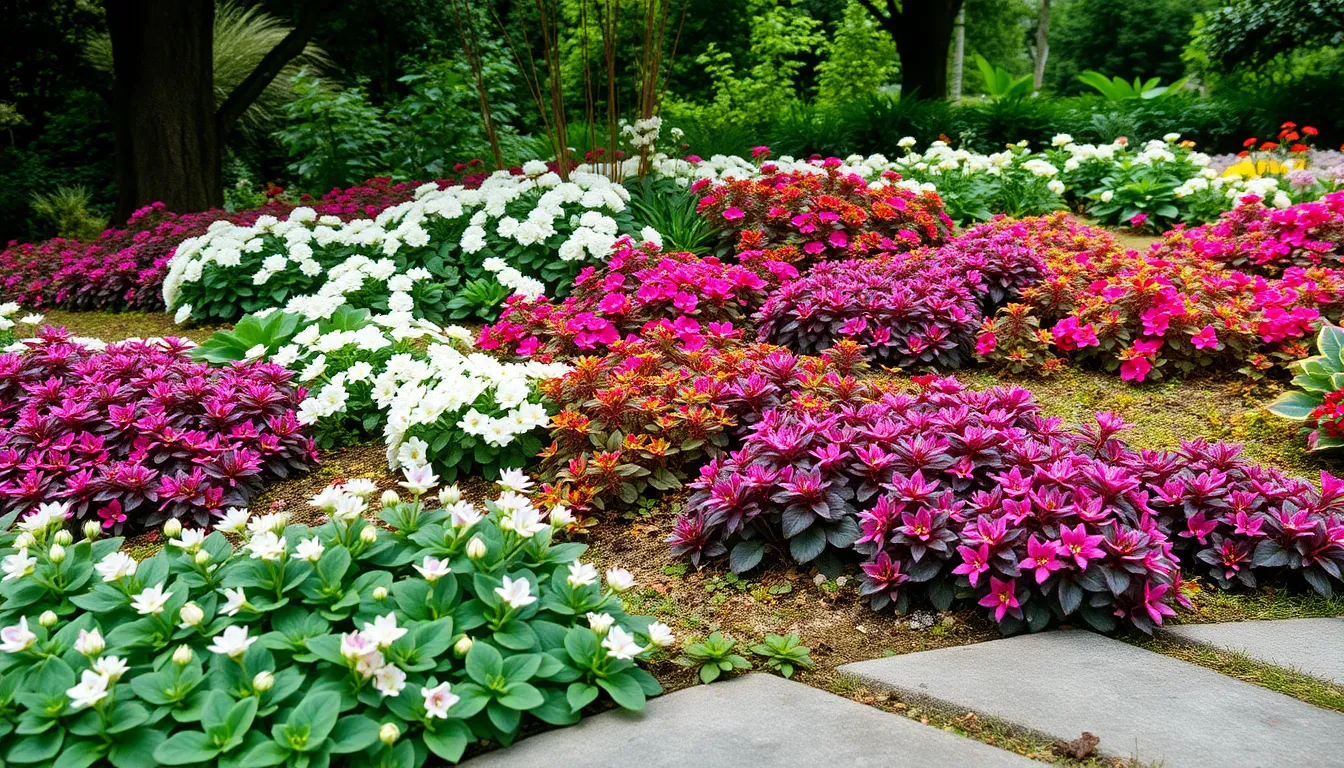
Flowering ground covers transform bare patches into vibrant displays that bloom throughout different seasons. We can create stunning visual interest while maintaining practical coverage by selecting varieties that offer both colorful flowers and attractive foliage year-round.
Sedum Varieties for Succulent Texture
Sedum species deliver exceptional low-maintenance ground coverage with their thick, fleshy leaves and diverse shapes that create unique textural interest. These succulents thrive in well-draining soil and full sun conditions, making them perfect for areas where other plants struggle to establish. We appreciate how sedum varieties require minimal watering once established, reducing garden maintenance while providing consistent coverage.
Hens and Chicks (Sempervivum spp.) offer another succulent option that’s ideal for low-maintenance gardens with their distinctive rosette-shaped appearance. These hardy plants create natural geometric patterns across the industry while requiring virtually no care once planted. We recommend combining different sedum varieties to create textural diversity that remains attractive throughout all seasons.
Lamium for Variegated Foliage and Blooms
Lamium maculatum excels in shaded areas where its variegated foliage and white or pink flowers create bright focal points. This versatile ground cover thrives in part shade and moist, well-draining soil, making it an excellent choice for challenging garden spots. We find lamium particularly valuable for adding color and texture to areas under trees or along north-facing foundations.
Variegated leaves provide continuous visual interest even when flowers aren’t blooming, creating a silvery-green carpet that brightens dark corners. The delicate blooms appear in spring and continue sporadically throughout the growing season, attracting beneficial pollinators to shaded garden areas. We suggest pairing lamium with hostas and ferns to create layered shade gardens with complementary textures.
Mazus for Small-Space Applications
Creeping Mazus (Mazus reptans) proves ideal for small spaces and pathways where its ability to handle foot traffic becomes invaluable. This compact ground cover features delicate, orchid-like white or purple flowers that create charming displays in tight quarters. We recommend mazus for areas between stepping stones or in rock gardens where space limitations require careful plant selection.
Mazus prefers moist, well-draining soil in full sun to partial shade, adapting well to various garden conditions while maintaining its compact growth habit. The small-scale nature of this ground cover makes it perfect for detailed garden work where larger varieties might overwhelm the space. We particularly value mazus in fairy gardens and miniature landscapes where its proportional flowers and foliage create appropriate scale relationships.
Install Grass Alternatives for High-Traffic Areas
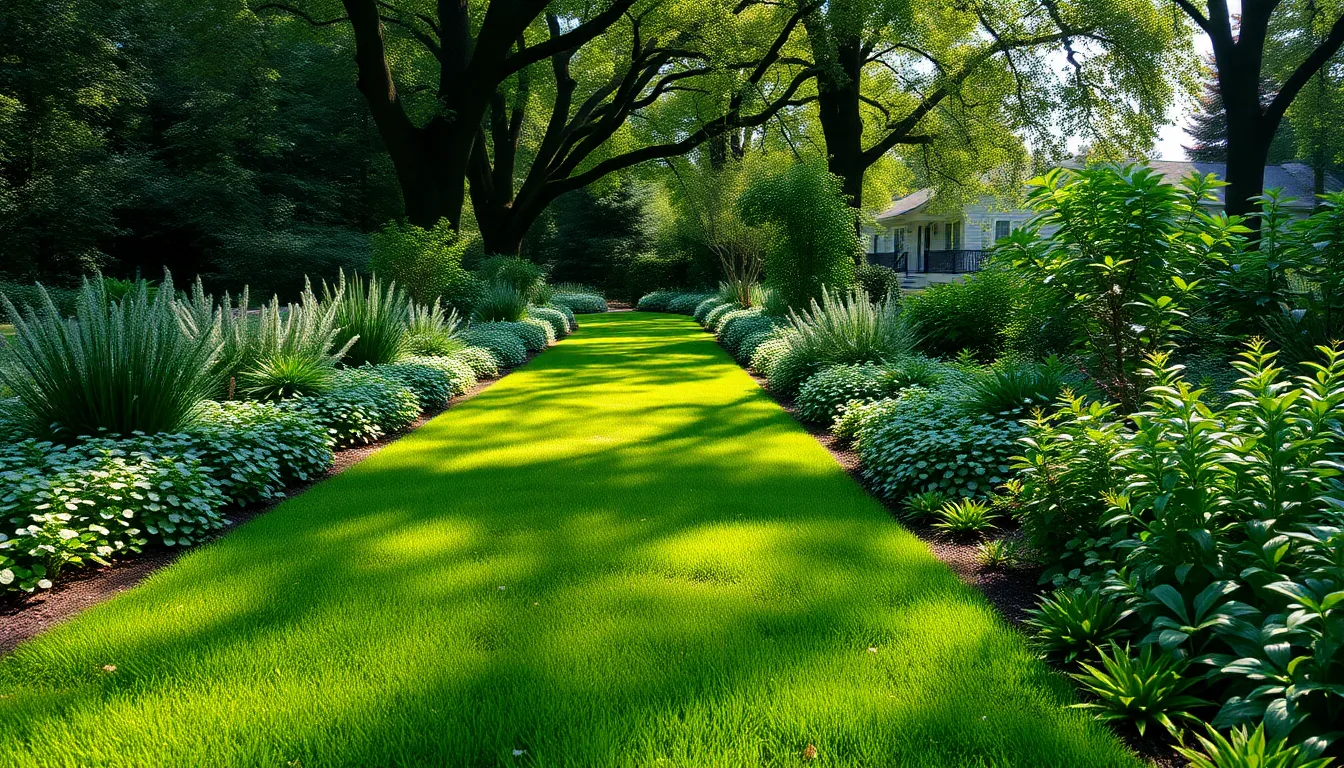
High traffic zones demand ground covers that withstand frequent footsteps while maintaining their beauty and functionality. We’ve identified three exceptional alternatives that excel in durability and offer unique benefits for busy garden pathways.
Clover for Nitrogen-Fixing Properties
Clover transforms high traffic areas into self-fertilizing zones through its remarkable ability to fix nitrogen directly into the soil. This practical ground cover choice enriches your garden naturally while requiring minimal maintenance compared to traditional grass lawns. We recommend clover for families seeking an eco-friendly solution that actually improves soil health over time.
White clover varieties tolerate moderate foot traffic exceptionally well, bouncing back quickly from compression. Dutch white clover specifically handles children’s play areas and pet runs while continuously adding nutrients to the surrounding soil. Micro clover options provide even finer texture for those preferring a more traditional lawn appearance.
Moss for Shaded Pathways
Moss creates dense, cushioned walkways in areas where traditional grass struggles to establish. Big Star Moss particularly excels in high traffic situations, forming resilient mats that handle frequent use while thriving in shaded, moist conditions. We’ve found this variety especially valuable for woodland garden paths and shaded shortcuts between garden beds.
Sheet Moss offers another excellent option for pathways receiving low to moderate foot traffic. This variety spreads naturally to create seamless green carpets that require virtually no maintenance once established. Moss pathways reduce erosion significantly while providing a soft, natural walking surface that complements shade gardens perfectly.
Corsican Mint for Fragrant Ground Coverage
Corsican Mint releases delightful fragrance with every footstep, creating sensory pathways that enhance the garden experience. This low growing ground cover thrives in moist, shaded areas while tolerating light foot traffic beautifully. We particularly appreciate how it transforms ordinary walkways into aromatic journeys through the garden.
Perfect for garden borders and pathway edges, Corsican Mint spreads gradually to form dense mats without becoming invasive. The tiny leaves create fine textured coverage that complements both formal and cottage garden designs. Light stepping actually encourages the release of its characteristic minty scent, making it ideal for frequently used garden paths.
Design Mixed Ground Cover Plantings for Visual Interest
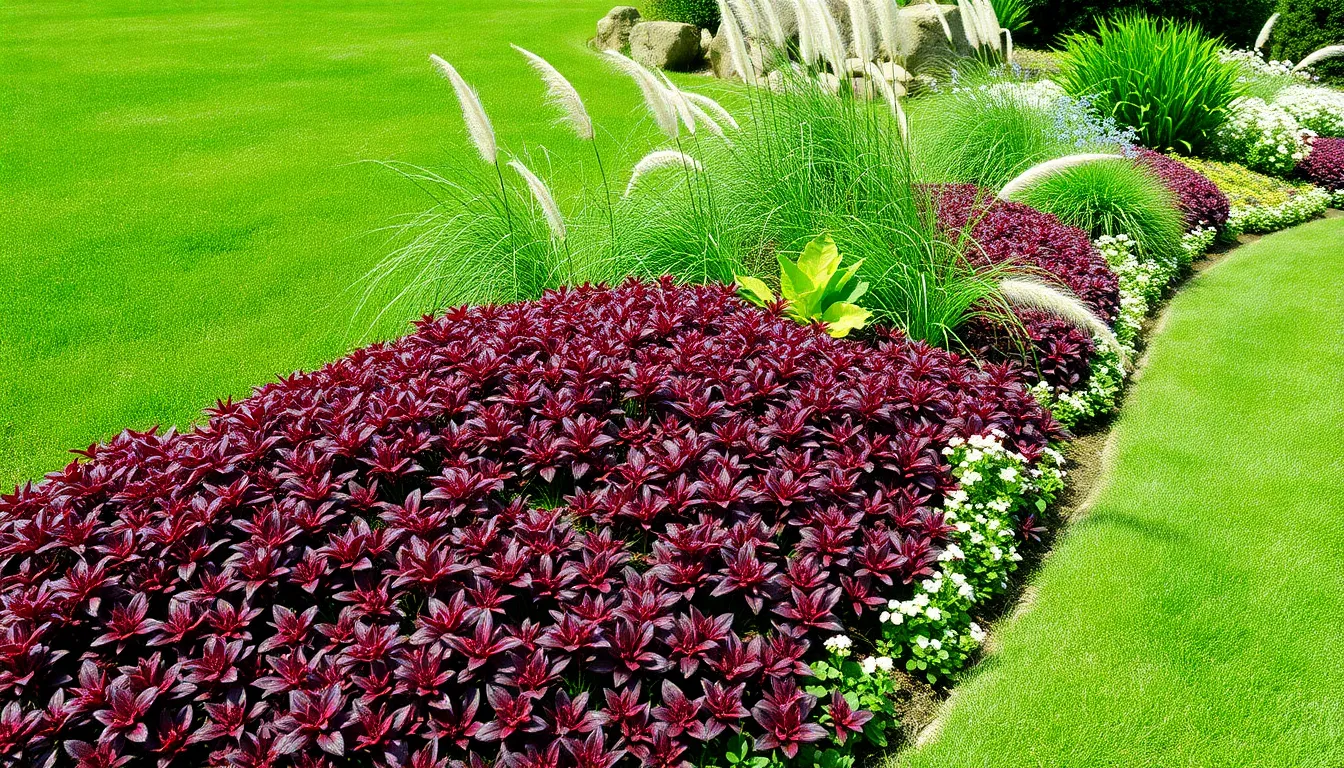
Creating ever-changing ground cover displays requires strategic layering of plants with varying characteristics. We’ll explore how combining different textures, heights, and seasonal elements transforms ordinary spaces into captivating industry features.
Combining Textures and Heights
Layering ground covers with contrasting textures creates visual depth that captures attention throughout the year. Dense, low-growing plants like Ajuga (Ajuga reptans) provide rich burgundy to bronze foliage that contrasts beautifully with the fine, delicate texture of ornamental grasses. Sweet woodruff (Gallium odorata) adds broad, evergreen leaves that complement these varied textures while maintaining year-round interest.
Architectural height variations enhance the overall design impact when taller plants anchor lower-growing spreaders. We recommend positioning plants that spill gracefully over edges, such as Cotoneaster ‘Coral Beauty’, to soften retaining walls and garden borders. This approach creates natural-looking transitions that feel organic rather than forced.
Strategic placement of plants with different growth habits prevents monotonous ground cover displays. Mixing evergreen varieties like common bearberry (Arctostaphylos uva-ursi) with seasonal perennials ensures continuous coverage while adding textural variety throughout changing seasons.
Creating Seasonal Succession Plantings
Planning for year-round interest requires selecting ground covers that peak at different times throughout the growing season. Spring flowering Ajuga provides early color with blue, purple, pink, or white blooms that kick off the garden’s annual display. Summer and fall grasses extend the show with changing foliage colors and interesting seed heads.
Winter elements become crucial for maintaining visual appeal during dormant months. Common bearberry offers bright red berries and persistent evergreen foliage that provides color when most other plants fade. Evergreen ground covers serve as the backbone that holds the design together through cold weather transitions.
Succession planting ensures something interesting happens in your ground cover display every season. We suggest combining early bloomers, summer performers, and winter interest plants to create a rotating showcase that never disappoints visitors to your garden.
Establishing Transition Zones Between Areas
Smooth transitions between garden zones require gradual changes in plant height, texture, and color rather than abrupt shifts. Ground covers excel at bridging the gap between lawn areas and shrub borders by providing intermediate scaling that feels natural to the eye. Plants that gradually increase in stature from one zone to the next create seamless connections.
Sloped areas benefit tremendously from mixed ground cover plantings that combine shrubs, trees, and low-growing spreaders. This layered approach stabilizes soil while creating visual harmony between different garden sections. Erosion control becomes an added benefit when properly designed transition zones prevent soil loss on hillsides.
Connecting sunny and shaded areas requires careful plant selection that accommodates changing light conditions. We recommend using adaptable ground covers that tolerate varying light levels to create smooth transitions that don’t look forced or artificial in the industry design.
Conclusion
Transforming those challenging spots in our gardens doesn’t have to be overwhelming. With the right ground cover selections we can create stunning landscapes that work with nature rather than against it.
Whether we’re dealing with deep shade or steep slopes these versatile plants offer us practical answers that require minimal upkeep. From the vibrant blooms of creeping phlox to the reliable coverage of pachysandra we have options that suit every garden situation.
The key lies in matching our plant choices to our exact conditions and design goals. By layering different textures and heights we create visual interest that lasts throughout the seasons.
Our gardens become more resilient and beautiful when we embrace these ground cover answers. They’ll reward us with years of low-maintenance beauty while solving our most persistent landscaping challenges.
Frequently Asked Questions
What are the best ground covers for shady areas?
Pachysandra and Vinca Minor are excellent choices for shady spots. Pachysandra thrives in deep shade, forming thick evergreen mats that suppress weeds. Vinca Minor adapts to various light conditions, from full sun to deep shade, offering glossy leaves and occasional blooms while requiring minimal maintenance.
Which ground covers work best for steep slopes?
Creeping Phlox and Vinca Minor are ideal for slopes. Creeping Phlox cascades beautifully over walls and fills gaps, while Vinca Minor stabilizes slopes and prevents erosion. Both varieties tolerate drought conditions and establish dense coverage that helps control soil movement on challenging terrain.
What are the fastest-spreading ground covers for quick coverage?
Ajuga, Creeping Thyme, and Wild Ginger are excellent fast-spreading options. These varieties quickly establish dense coverage in challenging areas, filling in spaces rapidly while providing attractive foliage and flowers. They’re perfect when you need immediate results in problem areas of your garden.
How do I create visual interest with mixed ground cover plantings?
Layer plants with varying textures, heights, and seasonal interest. Combine different growth habits and choose plants that peak at different times throughout the growing season. This approach creates captivating displays with continuous visual appeal, ensuring your garden looks attractive year-round rather than just during one season.
What are the benefits of using native ground covers?
Native ground covers support local ecosystems and require less maintenance than non-native varieties. Options like Wild Strawberry and Coral Bells naturally adapt to local soil and climate conditions, reducing the need for supplemental watering and fertilizing while providing habitat for beneficial insects and wildlife.
Which ground covers maintain their appearance during winter?
Evergreen varieties like Juniper, Ivy, and Pachysandra maintain visual appeal throughout winter months. These plants retain their foliage year-round, providing consistent color and texture even when other plants go dormant, ensuring your landscape looks polished during the coldest months.
How do I establish smooth transitions between different garden areas?
Create gradual changes in plant height, texture, and color rather than abrupt transitions. Use ground covers with varying characteristics to bridge different garden zones, creating seamless connections that enhance visual harmony. This layered approach also helps with erosion control on sloped areas.
What ground covers work well in poor soil conditions?
Creeping Phlox tolerates poor soil and drought conditions while still producing vibrant spring blooms. Pachysandra adapts to various soil types with minimal care requirements. These hardy perennials establish well even in challenging soil conditions where grass struggles to grow successfully.

